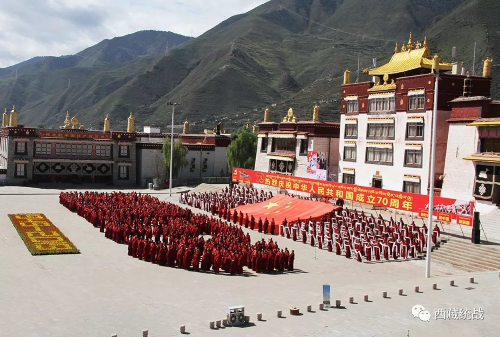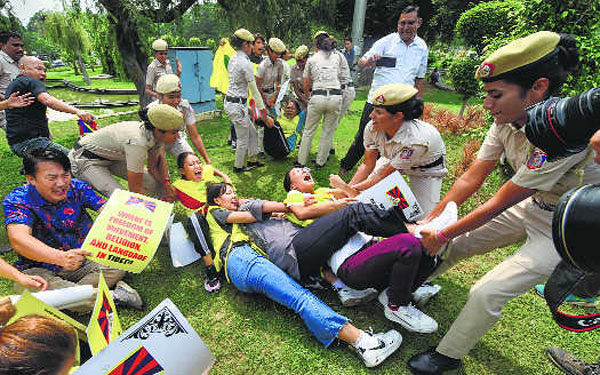
“No force can stop China’s onward march” was the message from Chinese President Xi Jinping during the 70th anniversary of the founding of the People’s Republic of China (PRC) on October 1. Celebrations in China centred around a military parade in Beijing which, according to the Ministry of National Defence, featured approximately 15,000 military personnel, 580 pieces of military equipment and 160 aircraft, along with several new military technologies unveiled for the first time.
The PRC was founded in 1949 following the victory of the Chinese Communist Party (CCP) over nationalist forces in the Chinese Civil War, and since then it has ruled the country uninterrupted. The year after its victory CCP forces invaded Tibet, and separately sided with North Korea in the Korean War.
The CCP also issued an extensive White Paper, China and the World in the New Era, to mark the occasion. The Paper states that China has not invaded a “single square of foreign land” in the past 70 years, nor provoked “a single war”. In fact, East Turkestan (Xinjiang), Inner Mongolia and Tibet are all under occupation and the CCP has launched three further conflicts in Korea, India, and Vietnam since its inception.

Photo: Free Tibet
In Tibet, a series of staged celebrations took place, with locals requested to show their love for the CCP and express their gratitude to the Party for having brought development and prosperity to the region. In Lhasa, 4,000 government officials, monks and other locals carried flags and ceremonial white scarves and sung the national anthem, all the while under intense security. Other events took place outside the capital, including at the Galden Jampaling Monastery in Chamdo City where monks hoisted the Chinese flag and hung a banner stating “may the great Communist Party last thousands of years” across the main entrance. Local sources are reported as saying that foreign tourists and other visitors were requested to leave Tibet in the lead-up to the anniversary.
In Hong Kong, amidst the ongoing unrest against the CCP, official celebrations were more scaled back and largely limited to a flag-raising ceremony closed to the public.
Four months of protests in the region were sparked by a proposed extradition bill but have since evolved into thousands voicing support for democracy and distrust of government from Beijing. Many are looking on with fear to 2047, when Hong Kong is set to become a fully-fledged region within China and lose greater autonomy.
Referring to the anniversary as a “Day of Grief”, protesters there demonstrated in defiance of a protest ban in place at the time, during which one activist, a high school student, was shot in the chest by police prompting widespread condemnation in the global media. This was the first time during all the recent protests that a live round was fired at a protester, with police have relied on tear gas and rubber bullets, and the occasional warning shots fired into the air to quell the unrest. More than 180 people were arrested following clashes with police, according to local media.
For many Tibetans in exile, the CCP’s anniversary served as a telling reminder of the atrocities perpetrated since its occupation of Tibet. The Central Tibetan Administration (CTA) pointed to the more than 150 Tibetans who have resorted to self-immolation in protest against the regime since 2009 alone, but also reiterated that “the past 60 years of Chinese occupation of Tibet is…a story of 60 years of Tibetan people’s peaceful resistance.” According to the CTA, over 1.2 million Tibetans have died and thousands of others have been imprisoned under China’s occupation.

In Delhi, 44 activists from the Tibetan Youth Congress (TYC) were detained after storming the Chinese Embassy to demand an end to China’s occupation of Tibet. The TYC stated in a press release that “until Tibetans, Uighurs, Southern Mongolians, Hong Kongers and Taiwanese people’s voices are respected…China’s celebration will only be in vain.”
The Uighurs are one of several persecuted Muslim groups in East Turkestan, the Xinjiang regionin northwestern China. Southern Mongolia is a territory annexed by the PRC in 1949, which has also suffered waves of ethnic cleansing and forced assimilation. Taiwan, long seen by Beijing as a rebel province, has struggled to secure official recognition as a separate country from China since 1949, when nationalist forces fled mainland China following their defeat in the civil war. And Hong Kong returned to Chinese rule in 1997 after being handed back from the UK, but retains a high degree of autonomy from the PRC.
In Queensland, Australia, a group comprising Tibetans, Uighurs, Hong Kongers and others joined together to protest against the CCP and called on Australia to support their nations’ struggles. Speaking to the group, President of the Queensland Tibetan Community Doring Tenzin Phuntsok said, “We are fighting against a common enemy that has might on its side…but it has not been able to crush our spirit which is as strong as CCP’s military might.”
According to news.com.au, thousands of people gathered in the Belgian and European Union capital
Brussels and other cities around the world to protest against the deteriorating
human rights under Beijing’s watch on the 70th anniversary day.




 Print
Print Email
Email